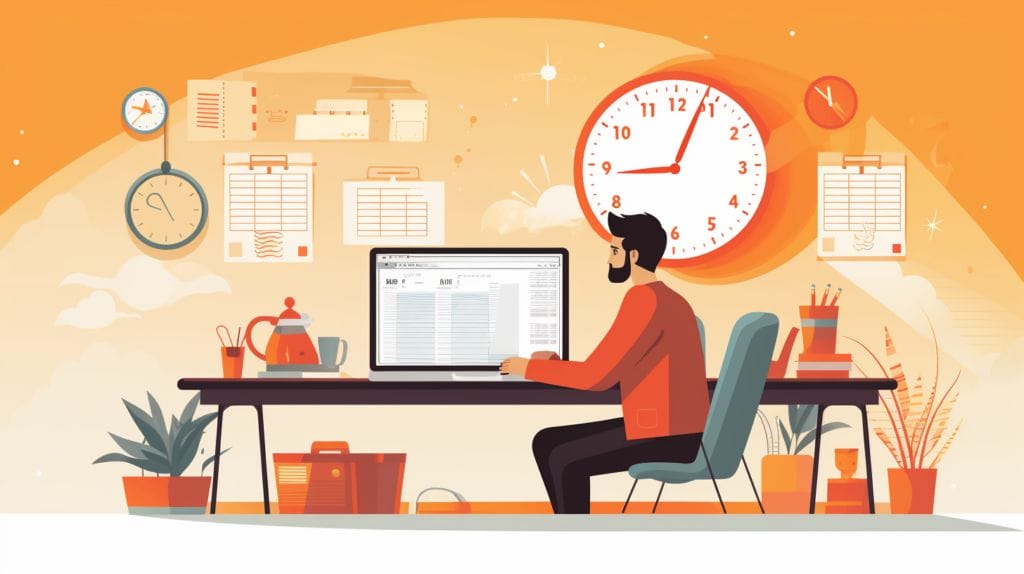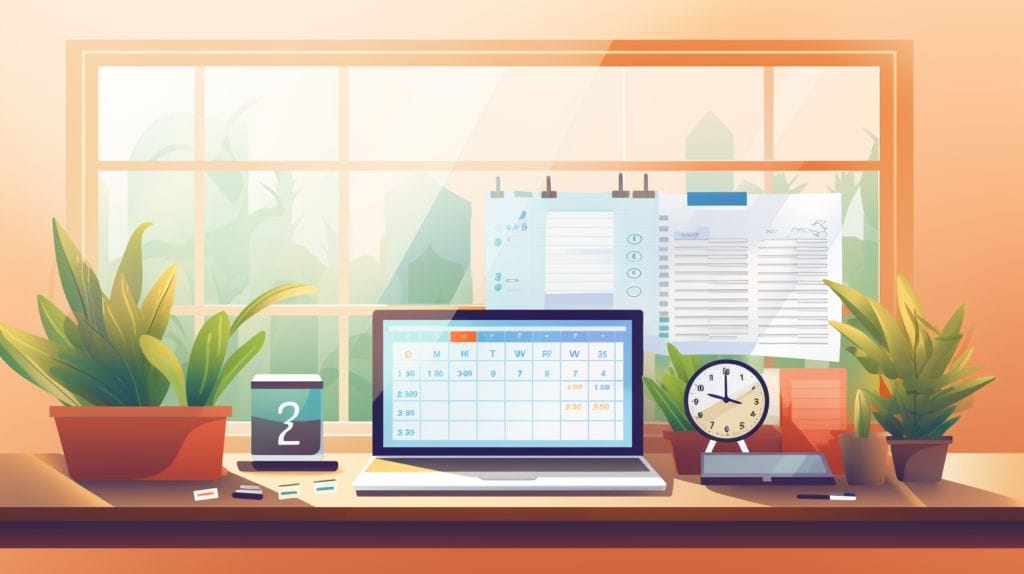My commitment is to help you in moving from part-time jobs or academic environments into a full-fledged professional career.
It’s a big shift, but don’t fret. I’ve been through it all and I’m excited to share my strategies for mastering your time, achieving work-life balance, building fruitful relationships at work, and prioritizing tasks.
Let’s settle you comfortably into your new normal and prosper in your steady job.
Key Takeaways
- Shift in mindset from part-time to full-time
- Reorganizing daily routine for increased structure and discipline
- Prioritizing tasks and effectively managing time
- Finding harmony between professional and personal life
Understanding The New Normal: The Transition to a Full-Time Job

Stepping into a full-time role is a significant change from part-time work. I’m here to help navigate this shifting landscape as you embark on your first 8 to 5 job.
We’ll also identify potential challenges you might face in your new work life and strategize ways to overcome them.
Analyzing the Steps from Part-Time to Full-Time
In my journey from part-time to full-time employment, I’ve had to navigate a series of changes and adapt to what I now understand as the new normal.
Analyzing the steps from part-time to full-time was crucial in this transition.
- The first step involved adjusting my mindset. Accepting that I was now working full-time hours was a major shift.
- Secondly, I’d like to reorganize my daily routine. This kind of work demanded more structure and discipline.
- Finally, learning to manage the increased workload was a key step. This meant handling more responsibilities and tasks.
In essence, the move required a comprehensive change in my approach to work. It was about understanding and embracing the new normal of employment.
Navigating the Shifting Work Landscape in Your First Full-Time Job
As I dove into my first 8 to 5 job, I quickly realized the work landscape was shifting, and I’d need to adapt swiftly to keep up with the pace.
My work schedule was no longer as flexible as during my part-time stints. I learned to prioritize tasks, effectively manage my time, and communicate my needs to my employer.
The work environment was demanding yet rewarding, making me more resilient and adaptable. Establishing a regular job schedule was instrumental in handling the transition.
While it was challenging, understanding the ebbs and flows of this new normal made my journey a lot smoother.
Identifying Potential Challenges Ahead in the Full-Time Work-Life
I’ve come to understand that anyone transitioning is likely to encounter a unique set of challenges. Achieving work-life balance while working can be daunting, especially when identifying potential challenges.
- Schedule: Maintaining a consistent schedule is crucial. Without it, you may find yourself overwhelmed by unexpected tasks.
- Workload: Managing your workload efficiently is important. Overworking can lead to burnout, hindering productivity in the long run.
- Adaptability: This often requires adaptability. Changes can occur at any time, and being prepared and flexible is essential.
Understanding these challenges is key to success. By identifying and addressing them early, you can confidently navigate your new work life.
Mastering Your Time: Developing a Robust Work Routine

Let’s discuss mastering your time and developing a solid job routine. I will share tips on creating a routine that boosts productivity in your full-time employment.
Incorporating personal needs into your job schedule is important for maintaining a healthy work-life balance. Additionally, using technology can make your duties more manageable and efficient.
Crafting a Routine that Maximizes Productivity in Your Full-Time Job
To maximize productivity, I’m crafting a routine that best utilizes my time and energy. I know that my weekly work hours are substantial and need to be used wisely.
To craft one, I’ve identified three key steps:
- Ranking Tasks: I first focus on tasks that generate the most value. This ensures my most productive hours aren’t wasted on trivial tasks.
- Establishing Breaks: I’ve learned that productivity isn’t about working non-stop. Breaks are essential to recharge and prevent burnout.
- Setting Boundaries: I’ve set strict boundaries for my working hours each week to ensure work-life balance.
This routine has greatly improved my productivity as an employee.
Integrating Personal Needs into Your Work Routine
While I’m working full-time, I must integrate my personal needs into my job schedule to maintain a healthy work-life balance. If I neglect my personal life, I risk burnout, which could affect my performance.
So, even if I work remotely, I set boundaries around my working hours and dedicate time to my personal needs.
Integrating personal needs into my job schedule, I allocate time for relaxation, hobbies, or just a quick exercise. This helps me recharge and continue to perform at my best.
Using Technology to Streamline Your Full-Time Job Duties
Before the dawn of each workday, I’m always keen on exploring how technology can streamline my job duties and help me master my time more effectively. In today’s fast-paced workplace, using technology to streamline your job duties is a game-changer.
- Automating work emails: I use email scheduling and automated responses to manage my shift hours smartly, keeping my inbox clutter-free.
- Task Management Tools: Apps like Asana or Trello help me track tasks, deadlines, and projects efficiently.
- Time Tracking Software: Tools like RescueTime allow me to analyze how I spend my shift hours, helping me optimize productivity.
Work-Life Harmony: Achieving a Good Work-Life Balance

Transitioning can often blur the lines between our professional and personal lives. We must understand the importance of balance in this context and set realistic boundaries to safeguard our personal time, especially when we might be working 40 hours a week.
We also shouldn’t forget to emphasize self-care amidst our job commitments, such as meditating during breaks.
Understanding the Importance of Balance in Full-Time Work-Life
In my journey of adjusting, I’ve realized that maintaining my work-life balance is key to my overall well-being and professional success, even when sometimes it feels like I’m working 50 hours a week.
Understanding the importance of balance in work-life isn’t just about managing my time. It’s about managing my energy, too.
Here’s my three-point strategy:
- Find a balance: I learned to avoid the extremes of overwork and underplay. It’s about creating harmony between my professional and personal affairs, ensuring I have time to hike and engage in other leisure activities.
- Prioritize: I’d like to identify what’s crucial in both spheres and focus on those. This helped me meet the standard for employment without neglecting my personal affairs.
- Set Boundaries: I designated specific times for work and rest. Setting clear boundaries helped me maintain a good work-life balance and ensure I had enough vacation days.
Setting Realistic Boundaries Between Work and Personal Life
I’ve found that setting a few realistic boundaries between my work and personal affairs and sticking to them has significantly improved my ability to balance both. Given the ever-demanding work culture, creating boundaries is crucial to preserve my life outside work.
The key to setting realistic boundaries lies in defining what’s negotiable and what’s not. Here’s a simple breakdown:
| Work Culture Aspect | Boundary | Non-Negotiable/ Negotiable |
|---|---|---|
| Work Hours | Fixed schedule | Non-negotiable |
| Breaks | Regular intervals | Non-negotiable |
| After-hours work | No emails/calls | Negotiable |
| Weekends | No work | Non-negotiable |
Making Time for Self-Care within Your Full-Time Work Commitments
Despite the hustle and bustle, it’s essential that I carve out time for self-care to maintain a healthy work-life balance.
A commitment to self-care helps me avoid feeling overwhelmed and promotes better mental and physical health, even when I can’t delete work-related thoughts from my mind. Here are three strategies I use:
- Prioritize: I identify what’s most essential in my daily schedule and ensure those tasks are accomplished first. This makes room for self-care activities.
- Schedule: I block out time in my calendar for self-care, treating it with the same importance as a business meeting.
- Practice Mindfulness: During breaks, I focus on the present moment, breathing deeply and calming my mind, which is a form of meditation.
These strategies help me to balance the demands of my job while making time for self-care.
Relationships that Matter: Navigating Interactions with Your Employer and Peers

Let’s now turn our attention to a critical aspect of full-time employment: navigating professional relationships. Building constructive relationships with your employer and colleagues is key, as is mastering clear and effective communication.
We’ll also explore some strategies for managing conflicts when they crop up.
Building Constructive Relationships with Your Employer and Colleagues
Often, I find it’s crucial to develop positive and effective relationships with both my employer and colleagues in order to thrive. Building constructive relationships with your employer and colleagues isn’t just about being friendly; it’s about understanding and meeting each other’s expectations.
Here are three tips to get you started:
- Understand the company’s culture: Every workspace has its own rhythm. Observe the hours when most people start working and adapt to it.
- Show initiative: Going beyond the minimum expected work is essential to stand out in a fast-paced environment.
- Promote open communication: Clear, respectful conversations help build trust and understanding.
Communicating Effectively in a Full-Time Work Environment
In my experience, there are four key elements I’ve found essential in effectively communicating:
- Clarity in your communication is crucial to avoid misunderstandings that might disrupt work between you and your peers.
- Empathy allows us to understand others’ perspectives, fostering a sense of being constantly connected, even in a busy work environment.
- Respect is a cornerstone for creating healthy relationships.
- Active listening: Active listening is an effective strategy that ensures your colleagues feel heard and valued.
Mastering these elements not only improves your communication skills but also positively impacts your work environment, enhancing productivity and job satisfaction.
Exploring Methods for Conflict Management at Work
Navigating through the subtle nuances of workspace relationships, I’ve discovered that mastering effective conflict management strategies is crucial for maintaining a harmonious work environment. Whether we work full-time or remotely, conflicts are inevitable.
- The first method I’ve been exploring is Active Listening. This involves genuinely hearing out the other party’s viewpoint, which often defuses the tension.
- Secondly, Assertive Communication allows me to express my thoughts clearly and respectfully, avoiding unnecessary confrontations.
- Lastly, Negotiation is a strategy I use to find a middle ground, creating win-win situations.
In essence, successful conflict management isn’t about avoiding disagreements. It’s about handling them in a way that promotes growth, understanding, and positive change within the work environment.
Prioritize and Prosper: Effective Strategies for Managing Daily Workload

Now, let’s shift our focus to how we can effectively manage our daily workload.
It’s all about mastering the art of prioritization, efficiently using project management tools, and effectively handling work pressures and deadlines.
These strategies will help us prosper in our jobs and make our work life more manageable and less stressful.
The Art of Prioritization in a Full-Time Work Setting
I’ve found that mastering five key strategies for prioritizing tasks can significantly improve your efficiency in a work setting. Prioritizing in a work setting isn’t just about managing tasks and spending time wisely.
- Urgent vs Important: Distinguish between what’s urgent and what’s important. Urgent tasks require immediate attention, while important tasks contribute to long-term goals.
- Delegate: If someone else can do a task just as effectively, delegate it.
- Weekly Schedule: Plan your week in advance. This gives you a clear view of your commitments inside and outside of work.
Working 8 to 5 can be a juggling act, but you’ll be more productive and less stressed with prioritization.
Leveraging Project Management Tools for Work Efficiency
In the realm of full-time employment, I firmly believe in the power of project management tools for increasing work efficiency. I’ve seen firsthand how these tools can transform how you manage your daily workload.
Leveraging project management tools for work efficiency helps to assign tasks effectively, reduces procrastination, and promotes sustainable work habits, which is crucial for those figuring out how to get used to working 8 to 5.
Consider how a simple tool can aid in managing daily tasks:
| Task Management | Benefit |
|---|---|
| Assigning tasks | Better team coordination |
| Setting deadlines | Reduces procrastination |
| Tracking progress | Ensures accountability |
| Prioritizing tasks | Enhances focus |
| Workload balancing | Promotes sustainable work pace |
Harness these tools and prosper in your work life.
Tips for Handling Work Pressures and Deadlines in Full-Time Occupations
Every day, I handle various work pressures and deadlines, and it’s essential for me to rank tasks to manage my workload effectively. Here are some tips for handling work pressures and deadlines:
- Exercise regularly – This helps me deal with stress and keeps me energized. It’s critical to make time for it, even during late nights.
- Utilize Vacation Days – I don’t let these go to waste. Vacations give me a needed break, and I return to work refreshed and more productive.
- Leaving the Office On Time – It’s tempting to work late. Still, I’ve found that leaving the office at a reasonable hour helps me maintain a healthy work-life balance.
These strategies have helped me thrive in my job.
Frequently Asked Questions
What Should I Pack for My Work Lunch?
I’d recommend packing a balanced lunch, including lean proteins, veggies, and whole grains. Don’t forget a piece of fruit for a sweet, healthy dessert! Keeping hydrated is also crucial, so pack a water bottle.
How Can I Deal With Workplace Stress and Anxiety?
I’ve found it helpful to take regular breaks, maintain a healthy lifestyle, and practice mindfulness to manage workplace stress and anxiety. I also set realistic goals and don’t hesitate to seek support when needed.
What Are the Best Ways to Commute to Work?
For commuting to work, I personally find public transport to be the most efficient. It’s cost-effective, reduces the stress of driving, and allows me to use travel time productively by reading or catching up on emails.
Is It Normal to Feel Overwhelmed During the First Few Weeks of Full-Time Occupations?
Absolutely, it’s quite normal to feel overwhelmed during the initial weeks. It’s a significant shift and requires adaptation. Remember, it’s a learning curve we all must climb. Hang in there!
How Can I Negotiate a Higher Salary or Benefits Package?
I suggest researching your industry’s salary standards and preparing a list of accomplishments. Demonstrate your value to the company, and don’t be afraid to ask for what you believe you’re worth.
Conclusion
So there you have it: transitioning to full-time occupations isn’t a walk in the park, but with the right mindset, time management, work-life balance, relationships, and effective prioritization strategies, it’s totally doable.
Remember, it’s all about finding your groove and making it work for you.
So, take a deep breath, buckle up, and get ready to dive into the exciting world of full-time employment.
You’ve got this!

